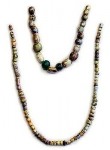 Archaeologists excavating Glencurran Cave in Burren National Park in County Clare, Ireland, have uncovered an unexpected treasure: a 1,150-year-old Viking necklace. It’s surprising because the piece is highly valuable so must have been treasured by its owner, but Vikings never settled in the Burren area.
Archaeologists excavating Glencurran Cave in Burren National Park in County Clare, Ireland, have uncovered an unexpected treasure: a 1,150-year-old Viking necklace. It’s surprising because the piece is highly valuable so must have been treasured by its owner, but Vikings never settled in the Burren area.
Some smaller, less significant Viking bead necklaces have been found in burials in Dublin. Nothing as glamorous as this, though.
[Excavation team leader Dr. Marion Dowd] said: “The necklace is the largest Viking necklace to have been found in Ireland. Normally, Viking necklaces that have been found have five to six glass beads, but this has 71 glass beads covered with gold foil.”
A leading expert on Irish cave archaeology, Dr Dowd said: “It is really bizarre how this necklace from a high-status Viking came to be in a cave in the Burren.
“There is no parallel for it in Ireland and it is puzzling on a number of fronts.
“The necklace would have been imported into Ireland from Scandinavia in the late 9th and early 10th century.
“Small numbers of these beads have been found with Viking burials at Kilmainham, Dublin, but nothing like the number found in Glencurran Cave. Such necklaces were worn by high-status Viking women and they might denote a woman’s cultural and religious affiliations. These were certainly prestigious items.”
Dr. Dowd speculates that the necklace might have come via Limerick. There was a Viking settlement there, so they may have traded with the Gaelic inhabitants of Burren.
Glencurran Cave has produced other finds in the 6 years since excavations began making it an archaeological gem even before actual jewelry was discovered. The current team has also found the skeletal remains of a two to four-year-old Bronze Age child, placed in the cave about 3,500 years ago, which is currently undergoing DNA testing. In addition, they’ve found the remains of seven adults, two other young children and one baby, plus the 10,000-year-old scapula of a bear.